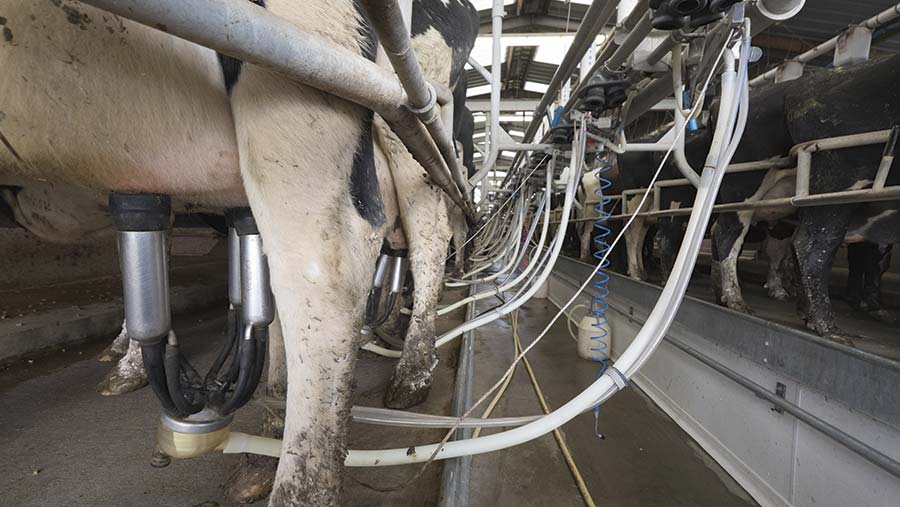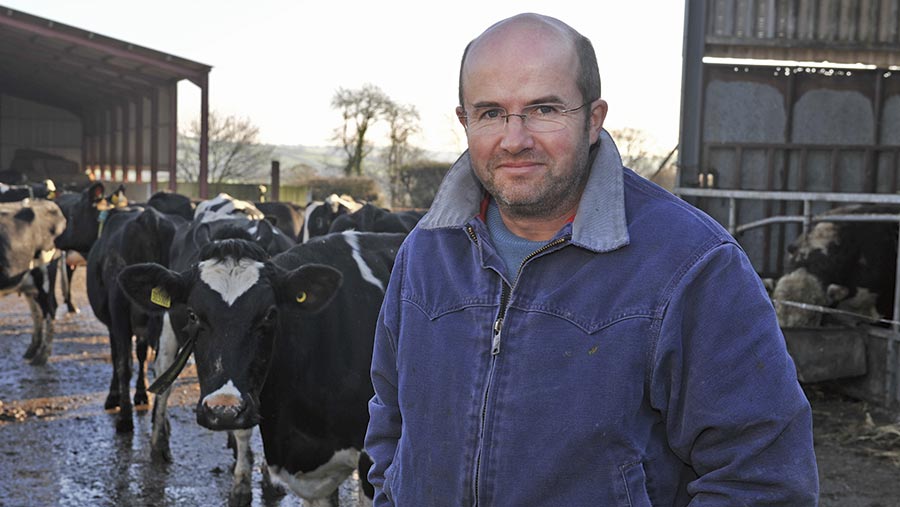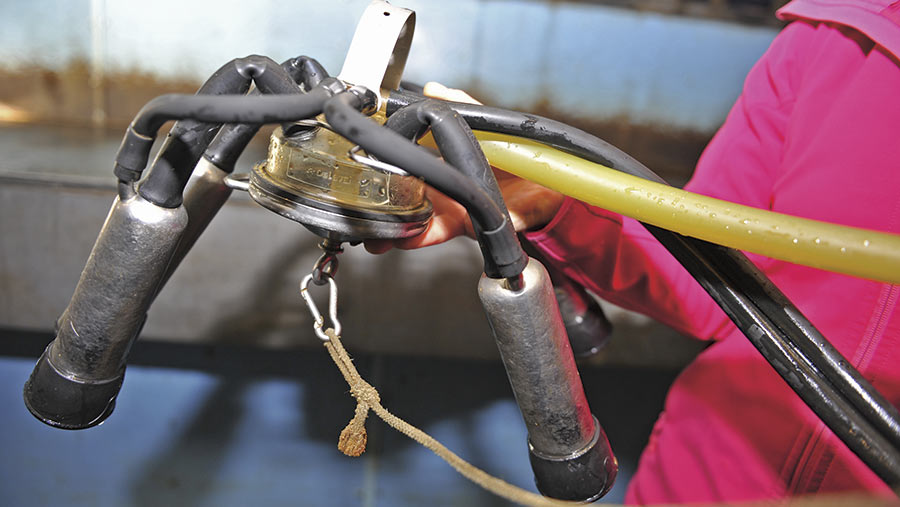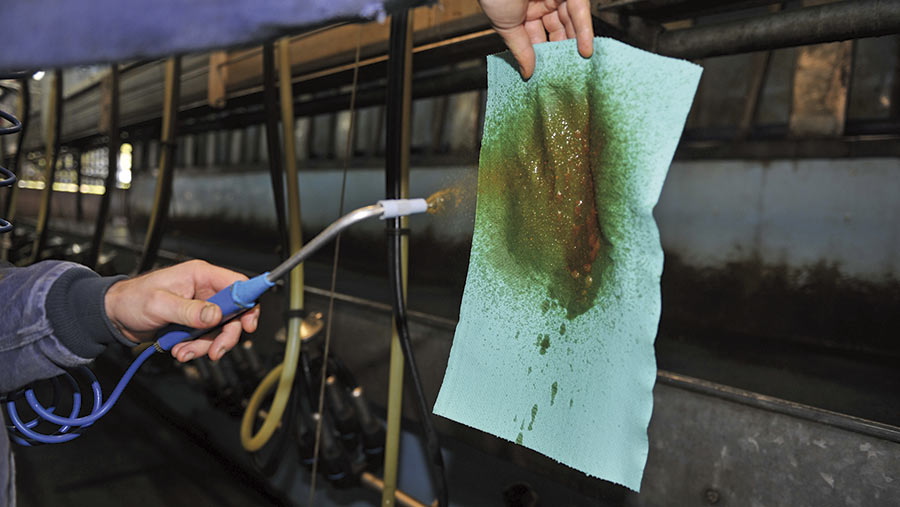Simple parlour adjustments save dairy farmer thousands
 © Tim Scrivener
© Tim Scrivener Simple milking parlour adjustments costing just 50p a cow are helping a Pembrokeshire dairy farming partnership improve teat hygiene and milk quality, and reduce annual concentrate costs by up to £30,345.
The Harris family milk 350 Holstein Friesian grazing-type cows on an organic system at Ffosyficer, a Farming Connect Focus Farm near Boncath.
The autumn-block calving herd is milked in a 15-year-old 20/40 herringbone parlour.
See also: Four ways to improve your milking parlour routine
Improving the milking routine has been a focus of a recent Farming Connect study at the farm.
That project revealed weaknesses in both the routine and the plant itself; shortcomings that were impacting on feed costs, milk quality and teat condition.
Among the faults were:
- Milk meters were incorrectly calibrated; some had a discrepancy of up to 15%
- Milk tubes were too long, leading to poor cluster alignment
- Teat disinfectant only covered around 50% of cow teats because the plastic nozzles on the spray units had deteriorated
- Cows were milked for 30 seconds longer than necessary, causing teat end damage and longer milking times
Milk meter calibration
The parlour is well maintained but with age and use come wear and tear, says Tom Harris, who farms with his wife, Francisca, and parents, Laurence and Eira.
“We had never calibrated the milk meters because they are electronic but some of them were out by up to 15%.”

Tom Harris is improve teat hygiene and milk quality with simple parlour adjustments
Cows were fed based on those readings which meant that feed rates could have been 15% higher or lower than needed.
This not only cost the business up to £86.70 a cow – based on 1.7t of feed at £340 – but the information was used to make breeding and culling decisions.
Ian Ohnstad, milking technology specialist at the Dairy Group, who has been working with Farming Connect on the project at Ffosyficer, advises that dairy farms with an average-sized herd should calibrate meters every year. For bigger herds, this should be done more frequently.
“As the herd size increases, the potential for losses and benefits also increases,” he says.
Mr Ohnstad recommends including calibration as part of the annual maintenance programme.
Milking tubes
The study at Ffosyficer also highlighted that milk tubes were too long, which meant that clusters were not sitting squarely on the cow and the udder quarters were being milked at different rates, leading to over and under milking.
“It is something that is easily overlooked unless you get a fresh pair of eyes in the parlour,” says Mr Harris.

Milk tubes have been shortened to sit squarely on cow udders
Tube length is critical to cows milking evenly; if there is uneven weight distribution on the teats they will milk out at different rates, leading to high cell counts, clinical infection and reduced yield. The somatic cell count at Ffosyficer is currently 180,000 cells/ml.
If teats are not milked correctly, they will regress and the udder will become uneven.
“The objective is to milk out quickly, gently and completely – and completely is the key part of this,” says Mr Ohnstad.
“Some farmers argue that uneven milking will balance itself out in a herringbone parlour because a cow will switch side at a subsequent milking. However anecdotal evidence has shown that around 80% of cows show a preference for one side or the other of the milking parlour.”
Teat disinfectant
One of the simplest and cheapest improvements made to the parlour was replacing the plastic nozzles on the teat spray guns.
The nozzles are plastic and the teat product slightly acidic so, combined with general wear and tear, they were only covering 50% of the teats with disinfectant.
At £1.50 each, it cost just £6 to replace all four.

Spraying the teat gun at a paper towel indicates if they are covering teats correctly
A simple test – spraying the gun at a paper towel – indicates if they are doing the job. The spray should form a perfect circle on the towel. “When we tested with the old nozzles the spray was coming out in a straight line,” says Mr Harris. “We spend around £1,500 a year on teat dip but so much of it was missing the teat.”
Mr Harris has also altered the wiping routine pre-milking. Cow teats had been wiped with a paper towel and the quarter stripped to check for mastitis and stimulate milk let-down. Those two jobs have now been switched.
“We do it the other way around so that the last touch on the teat is a clean wipe rather than a dirty hand,” Mr Harris explains.
He says farmers can invest heavily in mastitis prevention but, as he had discovered, solutions can be found in multiple small changes.
Encouraging farm staff to be involved in the changes is important too, he adds. He praised his cowman, Sam Kerr. “He has really taken ownership of the changes.”
Ffosyficer farm facts
- 1,214ha (3,000 acres) farmed
- 130ha (321 acres) milking platform
- All heifer replacements home-reared – 20% annual herd replacement rate
- Milk sold to Omsco and used in the production of the Daioni product range
- 121ha (300 acres) barley and oats grown for home use
- 6,500-litre annual milk yield average at 4.1% butterfat and 3.3% protein
- Herd calves from September to December
- Cows fed to yield in the parlour, up to a maximum of 5kg
Washable cloths favoured
Reusable towels for cleaning cow teats pre-milking have been shown to reduce levels of bacterial contamination in milk by 46% compared to paper towels.
A Farming Connect trial at Ffosyficer compared the Total Bacterial Count (TBC) in milk produced by cows wiped with washable cloths and disposable single service paper towels.
That trial showed that cows wiped with washable cloths had a 95.3% reduction in TBC compared with a control group that were not wiped. For cows whose teats were cleaned with paper towels, the reduction was 48.8%.
Ian Ohnstad, who managed the trial, says he was not surprised that the washable cloths were more effective but he was surprised by how much better they performed.
Mr Ohnstad says reasons why washable cloths are more effective are threefold. “They are slightly moist and the structure of the cloth is more fibrous which helps to remove contamination from teats. Their size is also more manageable.
“With paper towels, there is a tendency to have a long roll of paper bundled together or if you are being frugal a towel that isn’t quite large enough.”
